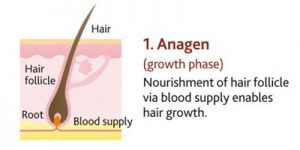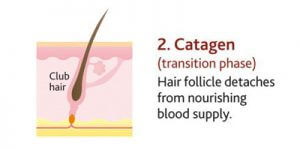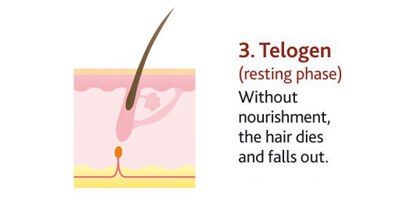Does Your Hair Really Undergo Changes On Regular Basis?
Hair is truly a crowning glory. People who have healthy and lustrous hair often appear confident about their looks and appearance. And, why not, healthy hair is an accessory; it does not need much styling.
On the other hand, people who have dull, dry and lifeless hair tend to have low self-esteem and always appear worried about their hair condition. Ageing is an inevitable part of our life. It causes several changes in the bodily functions that are reflected in some obvious signs such as wrinkled skin or even loss of hair. Ageing people show hair problems such as hair loss, greying of hair or even dry hair. However, some people face these hair problems much earlier in life. Poor nutrition, exposure to sun, mental stress, illnesses, medication, etc. are some of the contributing factors that cause hair problems. Did you know each hair on our head has a typical life cycle and that each hair falls out naturally after a certain period? In order to take good care of hair, one needs to understand the natural growth cycle of hair and this article explains the same in detail.


 During our lifetime, we have about 25 hair-growth cycles. It is important to note that the total number of hair usually remains constant, in spite hair going through different phases. Ideally the ratio between Anagen and the Telogen phase known as A/T ratio is usually 80:20. This means 80% of the hair is in growing phase and 20% are in the falling phase. Hair growth is also affected by seasonal changes. For instance, hair grows more quickly in summer than in winter and falls more in autumn than other seasons. The growth rate of hair also tends to slow down with ageing. The hair can grow to maximum length of 36 inches in women. It is rare to find hair exceeding 36 inches.
The falling of hair may also be affected by hormonal changes in body. In men, the male hormone androgen destroys the hair follicles and thus raises the risk of hair thinning or balding in men. In women, the balding is rare because of the protective action of estrogen towards the hair. However, in periods where estrogen levels fall, androgen can affect the hair follicle in women too. This happens in life stages such as menopause or even after delivering a baby.
Most of the females want their hair to grow too long and often they do complaint of not having good growth since beginning or complaints of scanty hair growth off lately.
To get yourself treated to increase the length of the hair you need to first understand how hair grows primarily and to give you a clear picture on how hair grows we have mentioned the points below so go through each of these very carefully.
The speed at which hair grows – It is really very important for one to know the speed average at which the length of the hair grows which comes to half an inch per month (1 to 2 cms a month or 0.3 mm to 0.5 mm a day).
During our lifetime, we have about 25 hair-growth cycles. It is important to note that the total number of hair usually remains constant, in spite hair going through different phases. Ideally the ratio between Anagen and the Telogen phase known as A/T ratio is usually 80:20. This means 80% of the hair is in growing phase and 20% are in the falling phase. Hair growth is also affected by seasonal changes. For instance, hair grows more quickly in summer than in winter and falls more in autumn than other seasons. The growth rate of hair also tends to slow down with ageing. The hair can grow to maximum length of 36 inches in women. It is rare to find hair exceeding 36 inches.
The falling of hair may also be affected by hormonal changes in body. In men, the male hormone androgen destroys the hair follicles and thus raises the risk of hair thinning or balding in men. In women, the balding is rare because of the protective action of estrogen towards the hair. However, in periods where estrogen levels fall, androgen can affect the hair follicle in women too. This happens in life stages such as menopause or even after delivering a baby.
Most of the females want their hair to grow too long and often they do complaint of not having good growth since beginning or complaints of scanty hair growth off lately.
To get yourself treated to increase the length of the hair you need to first understand how hair grows primarily and to give you a clear picture on how hair grows we have mentioned the points below so go through each of these very carefully.
The speed at which hair grows – It is really very important for one to know the speed average at which the length of the hair grows which comes to half an inch per month (1 to 2 cms a month or 0.3 mm to 0.5 mm a day).
The life cycle of your hair
Each hair is born in a hair bulb present in the hair follicles. The hair bulb is a miniature factory where the cell division takes place. As more and more cells divide, the older cells are pushed outside the hair bulb and it grows out as a hair shaft. The hair typically proceeds through three important phases in its growth cycle, Anagen, Catagen and Telogen. Let’s try to understand each of these stages in detail.1. Anagen
Anagen is the growth phase. The cell division happens rapidly, the older dead cells are pushed outside the hair bulb where they get keratinized and the baby hair starts to grow. The Anagen phase lasts for about 3 years. On an average each hair grows by half an inch each month. At any given time 85% of hair follicles are in growth phase.
2. Catagen
Catagen is the resting phase or transitional phase. The hair stops growing when it enters the Catagen phase and stays in this phase for about a month. At this stage the hair follicle from which hair strand has grown starts to shrink. However, the hair does not fall out and stands firm for some time. At any given time an average 1% of hair is in resting or Catagen phase.
3. Telogen
Telogen is the final phase and also known as the falling phase. This is the time where the mature hair falls off. This phase lasts for about 3 months. Once the hair falls out, the hair follicles re-enters the Anagen or the growth phase. At any given time approximately 10% of hair is in Telogen phase. During our lifetime, we have about 25 hair-growth cycles. It is important to note that the total number of hair usually remains constant, in spite hair going through different phases. Ideally the ratio between Anagen and the Telogen phase known as A/T ratio is usually 80:20. This means 80% of the hair is in growing phase and 20% are in the falling phase. Hair growth is also affected by seasonal changes. For instance, hair grows more quickly in summer than in winter and falls more in autumn than other seasons. The growth rate of hair also tends to slow down with ageing. The hair can grow to maximum length of 36 inches in women. It is rare to find hair exceeding 36 inches.
The falling of hair may also be affected by hormonal changes in body. In men, the male hormone androgen destroys the hair follicles and thus raises the risk of hair thinning or balding in men. In women, the balding is rare because of the protective action of estrogen towards the hair. However, in periods where estrogen levels fall, androgen can affect the hair follicle in women too. This happens in life stages such as menopause or even after delivering a baby.
Most of the females want their hair to grow too long and often they do complaint of not having good growth since beginning or complaints of scanty hair growth off lately.
To get yourself treated to increase the length of the hair you need to first understand how hair grows primarily and to give you a clear picture on how hair grows we have mentioned the points below so go through each of these very carefully.
The speed at which hair grows – It is really very important for one to know the speed average at which the length of the hair grows which comes to half an inch per month (1 to 2 cms a month or 0.3 mm to 0.5 mm a day).
During our lifetime, we have about 25 hair-growth cycles. It is important to note that the total number of hair usually remains constant, in spite hair going through different phases. Ideally the ratio between Anagen and the Telogen phase known as A/T ratio is usually 80:20. This means 80% of the hair is in growing phase and 20% are in the falling phase. Hair growth is also affected by seasonal changes. For instance, hair grows more quickly in summer than in winter and falls more in autumn than other seasons. The growth rate of hair also tends to slow down with ageing. The hair can grow to maximum length of 36 inches in women. It is rare to find hair exceeding 36 inches.
The falling of hair may also be affected by hormonal changes in body. In men, the male hormone androgen destroys the hair follicles and thus raises the risk of hair thinning or balding in men. In women, the balding is rare because of the protective action of estrogen towards the hair. However, in periods where estrogen levels fall, androgen can affect the hair follicle in women too. This happens in life stages such as menopause or even after delivering a baby.
Most of the females want their hair to grow too long and often they do complaint of not having good growth since beginning or complaints of scanty hair growth off lately.
To get yourself treated to increase the length of the hair you need to first understand how hair grows primarily and to give you a clear picture on how hair grows we have mentioned the points below so go through each of these very carefully.
The speed at which hair grows – It is really very important for one to know the speed average at which the length of the hair grows which comes to half an inch per month (1 to 2 cms a month or 0.3 mm to 0.5 mm a day).
